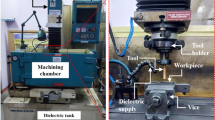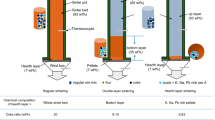Abstract
The minor and trace element content in coal is of great interest due to the potential impact on the environment from the release of these elements during combustion. Reducing the concentrations of potentially hazardous elements in coal prior to combustion is one way of dealing with this issue. In this research particle induced X-ray emission (PIXE) was used to investigate a hydrothermal leaching process for the removal of trace elements from a bituminous coal. The leaching agents HNO3 and NaOH were evaluated along with the effects of process parameters (temperature, pressure, and time) on the method's effectiveness. The variable with the greatest influence was the leaching agent itself. HNO3 was determined to be more effective than NaOH in reducing elemental concentrations for nearly all the elements determined. Increasing the temperature did result in greater reductions for some elements (Cl, Br, Zn) whereas increasing the pressure and duration of the leaching process had minimal impact on reductions, in elemental concentrations.
Similar content being viewed by others
References
1992 Keystone Coal Industry Manual, MacLean Hunter Publications, Chicago, IL, 1992.
R. B. Finkelman, J. Coal Quality, 12 (1993) 132.
R. B. Finkelman, Atomic and Nuclear Methods in Fossil Energy Research.,R. H. Filby, B. S. Carpenter, R. C. Ragaini(Eds), Plenum Press Corporation, New York, 1982, p. 141.
R. B. Finkelman, Fuel Proces. Technol., 39 (1994) 21.
V. B. Conrad, D. S. Kropcheck, Elemental Analysis of Coal and its By-products,G. G. Vourvopoulos (Ed.) World Scientific, Singapore, 1992, p. 97.
J. J. Kalvinskas, G. C. Hsu, Proc. Symp. on Coal Cleaning to Achieve Energy and Environmental Goals, Vol. 2, EPA-600/7-79-098b, 1979, p. 1096.
E. P. Stambaugh, H. N. Conkle, J. F. Miller, E. J. Mezey, B. C. Kim, Proc. Symp. on Coal Cleaning to Achieve Energy and Environmental Goals, Vol. 2, EPA-600/7-79-098b, 1979, p. 991.
E. P. Stambaugh, Coal Desulfurization: Chemical and Physical Methods,T. D. Wheelock (Ed.), ACS Symposium Series 64, 1977, p. 198.
G. A. Norton, H. G. Araghi, R. Markuszewski, Preprints of the American Chemical Society, Division of Fuel Chemistry, 30 (1985) 58.
J. A. Maxwell, J. L. Campbell W. J. Teesdale, Nucl. Instr. Meth., B43 (1989) 218.
F. E. Huggins, S. Srikantapura, B. K. Parekh, L. Blanchard, J. D. Robertson, submitted to Energy and Fuels (1996).
Author information
Authors and Affiliations
Rights and permissions
About this article
Cite this article
Blanchard, L.J., Robertson, J.D., Srikantapura, S. et al. PIXE analysis of the hydrothermal leaching of trace elements in coal. J Radioanal Nucl Chem 221, 23–28 (1997). https://doi.org/10.1007/BF02035237
Received:
Issue Date:
DOI: https://doi.org/10.1007/BF02035237




